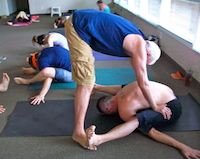ad-just-ment
noun
a small change that improves something or makes it work better
a change that makes it possible for a person to do better or work better in a new situation.
One of the most delicious and delicate aspects of the asana component of the practice of yoga comes in the form of an adjustment. Adjustments have the power to steady a trembling tree pose, turn a hesitant handstand into an empowering inverted experience, and provide reassurance in a restful child’s pose; essentially they can provide a compliment to any and every posture.
True to the Merriam-Webster dictionary definition described above, an adjustment is not a correction. To interpret an adjustment as a “correction” suggests that there is something incorrect or wrong about the student’s posture. An adjustment, much like an alteration to a piece of clothing, is intended to enhance the fit and ease of the posture, essentially, the way we wear it. While some of us are visual learners (find demonstrations of poses or techniques helpful) and others are auditory learners who lock in to each and every verbal cue the instructor gives, all of us need touch. Especially in this day and age, there are many ways to transmit information, yet nothing can replace the subtle guidance of non-verbal communication.
The Yoga Sutras of Patanjali illustriously reminds us that the physical postures are marked by the quality of “Sthiram sukham asanam.” According to this principle, every posture is sthira, steady and grounded while at the same time, sukham, sweet, light and joyful. While these qualities lay the foundation for our ability to be in a posture, they thereby serve as the guidelines by which we approach adjusting the posture as well. When a teacher is adjusting a student’s posture, it is an offering. The teacher is offering direction for steadying the pose as well as lightening the experience in the pose. We develop internal strength while simultaneously projecting graceful ease. So ultimately, the information we receive through an adjusted posture offers a profound realization; what might appear to be a barrier can be dissolved. It gives us an opportunity to BE in the pose, liberating us from attachment to doing the pose. For a student to find ease and security in receiving an adjustment, it is helpful to be well informed, realizing that the quintessential adjustment is a product of well-meaning intention, perpetual curiosity and ongoing study. Teachers learn adjustments like any other aspect of asana, so when a teacher offers an adjustment, subsequently they are offering a tool from their own study kit.
While adjustments offer a multitude of enhancements to the physical practice of yoga, they are not for everyone. It is always a good idea for teachers to declare his/her own policy on adjustments at the beginning of practice. Some teachers will ask students straight up if they prefer not to be adjusted to raise his/her hands, while others more discretely suggest raising a hand in child’s pose or flipping a corner of their yoga mats under. One suggestion is to start class by asking if there is anything the students want to work on that particular day. It gives people who have injuries, expectant mothers, even daily devotees, a chance to check in with their bodies in that present moment. Regardless, it is a good idea not to rely on the teacher’s announcement and instead discuss any questions, issues, or concerns prior to the start of class. If that opportunity doesn’t present itself and an adjustment is given, yet does not offer the components of steady and sweet, the student most definitely should inform his/her teacher that it is not comfortable. Remembering that part of adjusting is directing prana and creating the space for the breath to move; if a student finds his/her breath becomes restricted in any particular adjustment, then a very direct way of signaling that is to say “5” (as in they have fulfilled the 5 breath hold in the pose and are ready to release).
Our experiences on our yoga mats often illuminate much of how we are inclined to handle experiences off of our mats as well. Adjustments are powerful tools, not only for the physical aspect, but also in terms of deepening our awareness of ourselves, magnifying how we respond to different situations and circumstances. While nothing is more rewarding than navigating the terrain of our bodies independently, there is something amazingly magical about being reminded that we are not alone. The subtle guidance in an adjustment, along with the silent reminder that we are being supported, is one of the most powerful forms of energy. It is that energy that allows us to “yoke” in the ultimate spirit of yoga, to connect deeper with ourselves and stronger with those around us.

